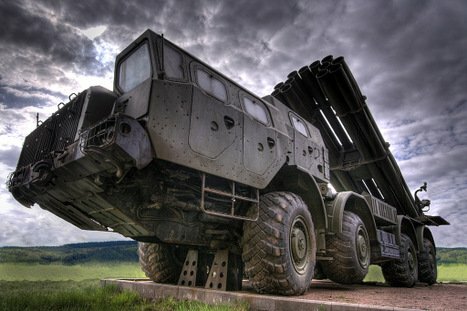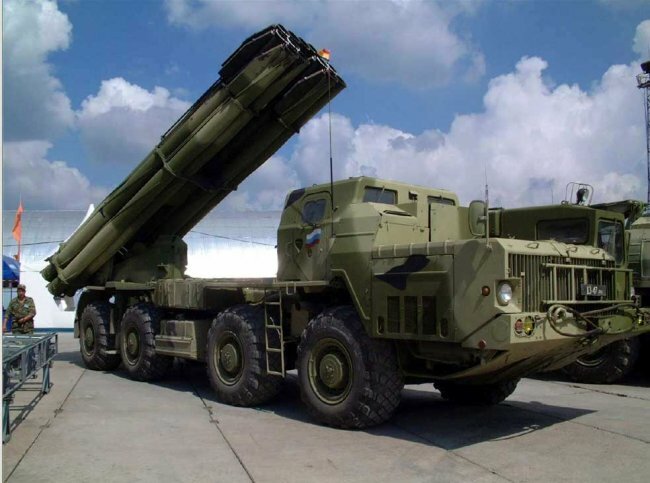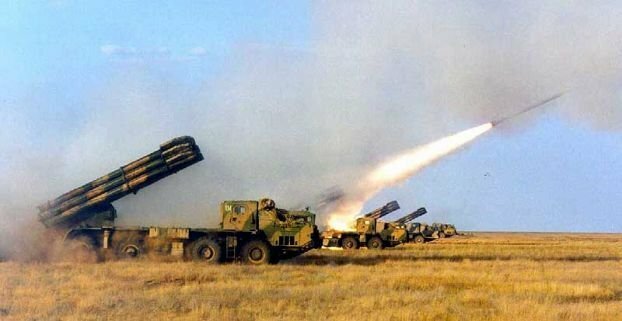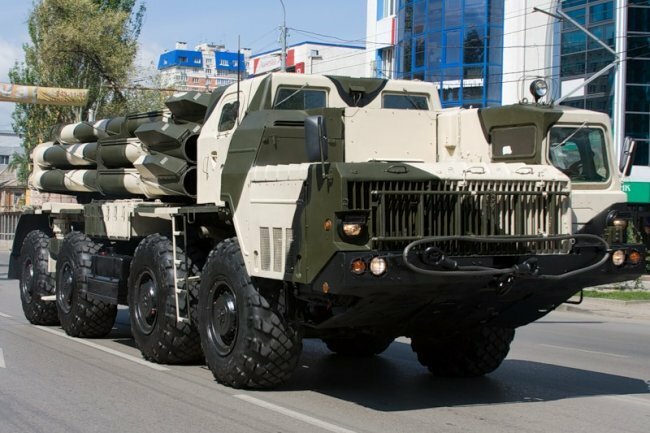Fire Tornado

weaponry
The 9М55К missile with a fragmentation warhead. Contains 72 combat elements, carrying 6912 ready-made heavy shrapnel, designed to effectively defeat enemy light and unarmoured vehicles, and 25920 ready-made light shrapnel, designed to destroy enemy manpower; total 32832 shard. The 16 shells contain 525312 ready fragments, an average of one shard per 1,28 m² of lesion area (672000 m²). Designed to defeat manpower and unarmored military equipment in the places of their concentration, the most effective in open areas, in the steppe and desert.
Missile 9М55К.
Missile weight - kg 800
Missile length - 7600 mm
Head Weight (9H139) - 243 kg
Weight of the combat element (9Н235) - 1,75 kg
Number of ready striking fragments - 96 for 4,5 g, 360 for 0,75 g
Projectile self-destruct time - 110 with
Maximum range - 70000 m
Minimum range - 20000 m

9M55K1 missile with self-aiming warheads. The 9N142 cartridge warhead carries 5 Motiv-3M self-aiming warheads [1] equipped with dual-band infrared coordinators looking for a target at an angle of 300. Each of them is capable of penetrating at an angle of 300 armor of 700 mm, that is, to hit any existing and promising armored vehicles. Ideal for use in open areas, in the steppe and desert, it is almost impossible to use in the forest, it is difficult to use in the city. Designed to defeat the top groups of armored vehicles and tanks.
Missile 9М55К1.
Missile weight - kg 800
Missile length - 7600 mm
Head Weight (9H152) - 243 kg
Weight of the combat element (9Н235) - 15 kg
Dimensions of the combat element - mm 284х255х186
The weight of the explosive in the combat element - 4,5 kg
Self-destruction time of the combat element - 60 with
Maximum range - 70000 m
Minimum range - 25000 m
9M55K4 missile with warhead for anti-tank mining areas. Each projectile contains 25 anti-tank mines, all in one salvo of the 300 anti-tank mine. It is intended for the operative remote staging of anti-tank minefields, both in front of enemy military equipment units located at the turn of attack, and in the area of their concentration.
Missile 9М55К4
Missile weight - kg 800
Missile length - 7600 mm
Head Weight (9H539) - 243 kg
The number of combat elements in the head part (anti-tank mines) - 25
Dimensions of the combat element - 33х84х84
The weight of the combat element (anti-tank mine) - 4,85 kg
The weight of the explosive in the combat element (anti-tank mine) - 1,85 kg
Projectile self-destruct time - hours 16-24
Maximum range - 70000 m
Minimum range - 20000 m

The 9М55К5 projectile with warhead with cumulative fragmentation combat elements. The cassette warhead contains 646 combat elements weighing 240 g, having a cylindrical shape (118x43x43 mm). Normally able to punch up to 120 mm homogeneous armor. The most effective against motorized infantry on the march located in the BTR and infantry fighting vehicles. In total, 16 shells contain 10336 combat elements. Intended to destroy open and sheltered personnel and lightly armored military equipment.
Missile 9М55К5.
Missile weight - kg 800
Missile length - 7600 mm
Head Weight (9H176) - 243 kg
Weight of the combat element (9Н235) - 240 g
Maximum range - 70000 m
Minimum range - 20000 m
The 9M55F missile with a detachable high-explosive fragmentation warhead. Designed to destroy manpower, unarmored and lightly armored military equipment in the places of their concentration, the destruction of command posts, communications centers and objects of the military-industrial structure.
Missile 9М55К.
Missile weight - kg 810
Missile length - 7600 mm
Head weight (index unknown) - 258 kg
BB weight in the head section - 95 kg
Number of ready striking fragments - 110 by 50 g
Maximum range - 70000 m
Minimum range - 25000 m

The 9М55С missile with a thermobaric head part. The explosion of one projectile creates a thermal field with a diameter of up to 25 m (depending on the terrain). The field temperature is over 10000С, the time of existence is no less than 1,4 with [2]. It is intended for the defeat of manpower, open and sheltered in fortifications of an open type and objects of unarmored and lightly armored military equipment. It is most effective in the steppe and desert, a city located on a non-hilly terrain.
Missile 9М55С
Missile weight - kg 800
Missile length - 7600 mm
Head weight (index unknown) - 243 kg
BB weight in the head - 100 kg of mixture
Maximum range - 70000 m
Minimum range - 25000 m
9М528 missile with high-explosive fragmentation warhead. Fuse pin, instant and slow action. Designed to destroy manpower, unarmored and lightly armored military equipment in the places of their concentration, the destruction of command posts, communications centers and objects of the military-industrial structure.
Missile 9М528
Missile weight - kg 815
Missile length - 7600 mm
Head weight (index unknown) - 258 kg
BB weight in the head section - 95 kg
Number of ready striking fragments - 880 by 50 g
Maximum range - 90000 m
Minimum range - 25000 m
Missile with an unmanned aerial vehicle reconnaissance (UAV). Designed to conduct reconnaissance for twenty minutes, and almost invulnerable, because small in size, and goes directly over the target, delivered directly to the rocket.
UAV projectile
Missile weight - kg 800
Weight UAV - 42 kg
Self-flight time over the target - 30 min
Flight altitude - 200 — 600 m
Maximum range - 90000 m
Minimum range - 20000 m

Advantages
Multifunctionality, maneuverability, high reliability, accuracy and power. A battery volley of six Smerches can stop the advance of an entire division or destroy a small town.
Disadvantages
The high cost and difficulty of use in local conflicts, where often the enemy acts in settlements, the use of which "Smerch" would lead to their complete destruction.
Information